Food farmers are making it work in sweltering Arizona, offering lessons for farmers in other regions where summer temperatures are rising.
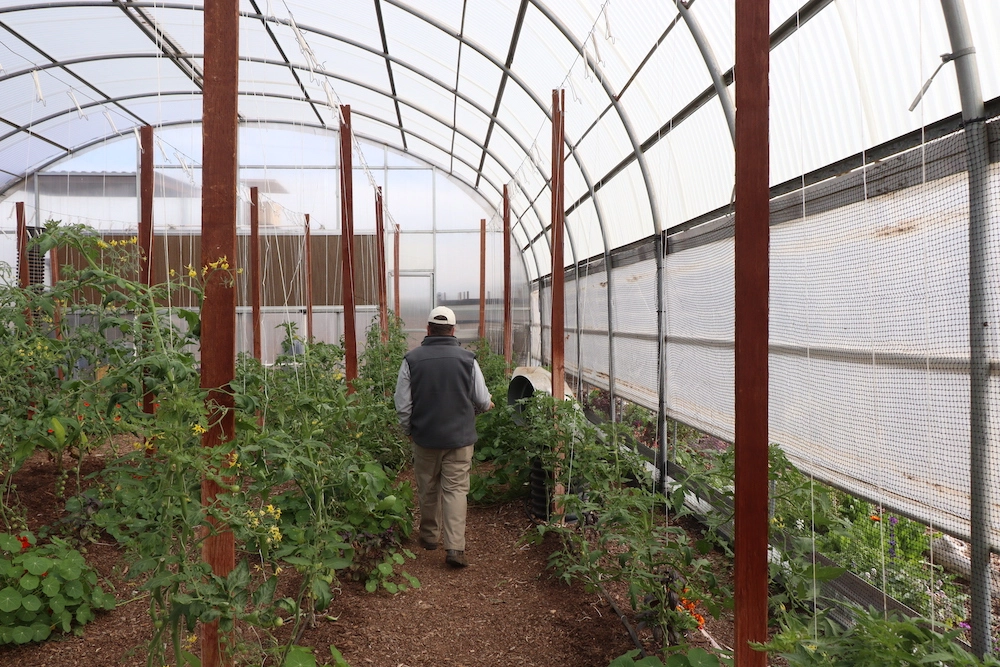
When most people think about Phoenix, Arizona, they probably aren’t thinking about agriculture. The city—and its many surrounding cities—is incongruously spread over a low-desert chunk of the Sonoran Desert. It’s hot for more than half the year (typically ranging from 80 to 115 degrees Fahrenheit) and rainstorms are few and far between. And yet, even in these harsh conditions, people are growing food, and they’re growing it well.
In 2023, Phoenix endured record-breaking heat that had residents coping with an entire month of daytime temperatures that never dropped below 110 degrees Fahrenheit, with the typical monsoon rains nowhere in sight. While other regions may not be quite so blistering, hotter temperatures and less rain in certain areas are likely to become more common as climate change, driven by the burning of fossil fuels, warms the planet. In Phoenix, where a harsh climate has always been more or less the norm, gardeners and farmers have been adapting for centuries, and they have wisdom to share. Their top tips? It all comes down to shade and soil.
The native soil of Phoenix is often very clay-heavy, high in poor drainage and low in organic material. When it is exposed to the sun, it dries quickly and cracks, cooking anything below. This type of earth is fine for native food plants such as prickly pear cactus. But to grow more food, the soil needs to be both protected from the sun and built up with organic material for nutrients.
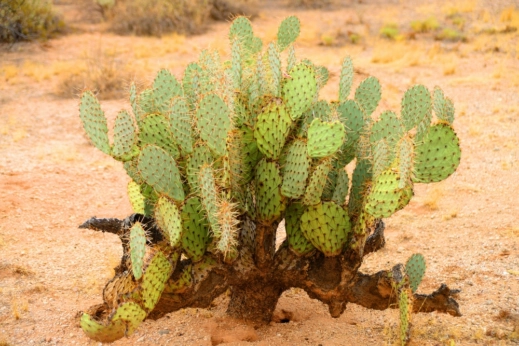
Phoenix’s clay soil is ideal for native plants such as the prickly pear cactus. (Photo: Shutterstock)
Rose Courtney is an urban gardener who has transformed her backyard into a food forest where she grows year-round. She even had a bumper crop during last year’s seemingly unending heat wave. In July, she was still growing vegetables such as carrots, kale and cucumbers, tending to her garden early in the morning, when the temperatures were in the 90s instead of the triple-digits.
“Invest time and energy in permanent [shade] structures,” she advises. “Without that, you’re not going to have a lot of success.”
Shade comes at two levels for desert gardeners—shade for the plants with shade cloth or trees and shade for the soil in the form of groundcover. At the Arizona Worm Farm, permanent shade structures, trees and wood chip mulch are all part of the soil-health strategy, too. In fact, owner Zach Brooks says that the mulch is potentially even more important than the shade—combined with high microbial activity, it keeps the soil moist and allows for a system of deep watering, less frequently.
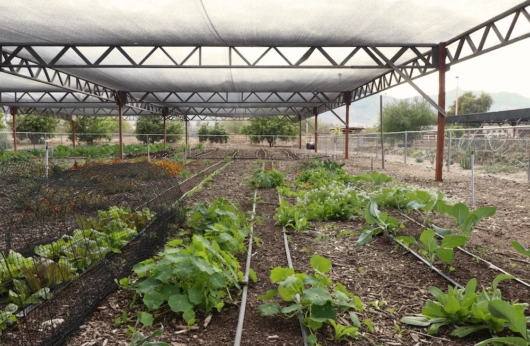
Permanent shade structures help protect crops from the hot Arizona sun. (Photo: Callie Radke Stevens)
“What happens three or four feet underground to 18 feet underground is more important than what happens above ground,” says Brooks. “So, keeping your soil covered that’s how we get away with watering as infrequently as we do and having good results for the time periods that we do.”
In the summer, the Arizona Worm Farm’s combination of shade (from both 50 percent shade cloth and trees), mulch and active soil keep the farm’s air temperature about 30 degrees cooler than the ambient temperature of the city. So, when it’s 110 degrees Fahrenheit at Sky Harbor Airport, where the city’s temperature readings are taken, it’s a balmy 80-85 degrees seven miles away at the farm.
Brooks and his team grow food on the farm roughly from October to April, excepting the trees in the food forest, where at least one of the 118 trees is producing food year-round. This fall and winter growing season is common in the Valley of the Sun, where even cold snaps are short and relatively temperate. By planting in the fall and harvesting in the spring, growers can maximize cooler temps and wetter weather—and gardening days that are a little less sweltering.
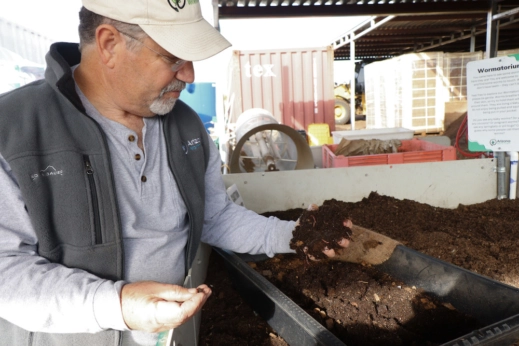
Zach Brooks of the Arizona Worm Farm shows off the work of composting worms. (Photo: Callie Radke Stevens)
Michael Chamberland is an assistant agent for the University of Arizona Cooperative Extension, a service of the University of Arizona. The extension provides resources for gardening all over the state. “What we’ve done here is taken advantage of the fact that our winter is cool and sunny and so we can grow things through the cool season,” says Chamberland.
Chamberland also pointed out that it isn’t as simple as just swapping seasons. Seedlings are growing in temperatures that go from hot to cold instead of cold to hot, and the days are much shorter than a summer growing season. While you can grow almost anything in the desert with enough shade and water, it makes more sense to look for things that are better adapted to short days and low water use.
Sierra Penn is the Indigenous Garden Educator for NATIVE HEALTH and runs a traditional garden on an urban lot in partnership with Keep Phoenix Beautiful. There, she plants in rows as well as using methods such as the Pueblo Zuni waffle beds and Akimel O’odham flood irrigation with water from Phoenix canals.
Both techniques make it easier to water deeply and less frequently (another theme among the growers). In fact, many of those modern canals are built following the ancient canal systems dug by the Hohokam or Huhugam people thousands of years ago. Growing food in the Sonoran Desert is nothing new.
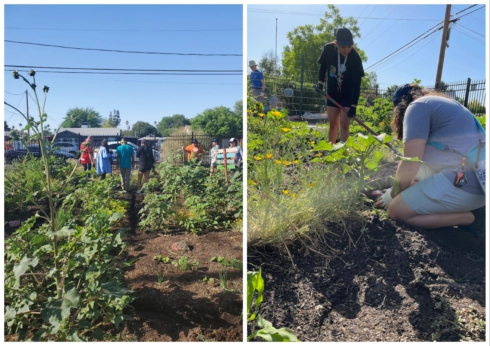
NATIVE HEALTH’s traditional garden incorporates Indigenous irrigation practices. (Photo courtesy of NATIVE HEALTH)
The garden is a teaching garden, and Penn runs workshops on everything from growing luffas to using grow bags to get started. Over the years, the garden has produced food such as brown tepary beans, Diné blue corn, Tohono O’odham melons and other traditional plants that grow well in the low-desert heat.
“I think it really helps them to kind of find that connection to ground themselves,” Penn says of the people who attend her workshops. “I think gardening is very grounding and just connecting us to our roots.”
Like most food growers, Phoenix farmers and gardeners have an extensive web of knowledge sharing within the region, too. Penn says that she didn’t have much experience when she started and has learned from Keep Phoenix Beautiful’s master gardener, who also knows about the traditional gardening methods, the garden employees and Native Seed/SEARCH, a southern Arizona nonprofit and heirloom seed source.
This knowledge web is particularly important in the urban, arid city because many gardening resources center on a longer growing cycle that has more lively soil and more water.
“People get confused because they go on to these blogs and somebody in Minnesota is doing something spectacular, and it doesn’t work in Phoenix,” says Brooks. “If you follow Phoenix-based bloggers, then you get good advice.”
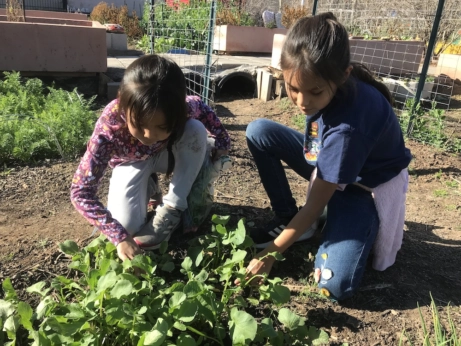
The traditional garden offers workshops and grows traditional plants such as Diné blue corn and Tohono O’odham melons. (Photo courtesy of NATIVE HEALTH)
The other gardeners agree. Penn has been diving deep into the gardening practices of Indigenous Arizona tribes, and Courtney looks for plants that grow well in similar climates. As the climate becomes less predictable, knowing how to successfully grow food in harsh environments will be vital. Just as these food growers have done, sharing knowledge will be equally as important.
“I think my biggest tip would be to look at it as an experiment of trying something new, and if it fails, don’t be afraid to try again because you could create something bigger and better,” says Penn.
Each of these desert gardeners shared failures, from pests to putting the wrong plant in the wrong soil. But they have also kept going, turning a suburban backyard, a cotton field and a misused urban lot into thriving food plots. As we rethink food systems, trying something new and creating something bigger and better might be just what we need.
Yes, answers that apply to the “drylands” 1/3 of the continental U.S.! 50 how-to’s in 50 minutes to manage dryland house, garden, and neighborhood water (may apply universally). https://www.youtube.com/watch?v=KcAMXm9zITg&t=2551s